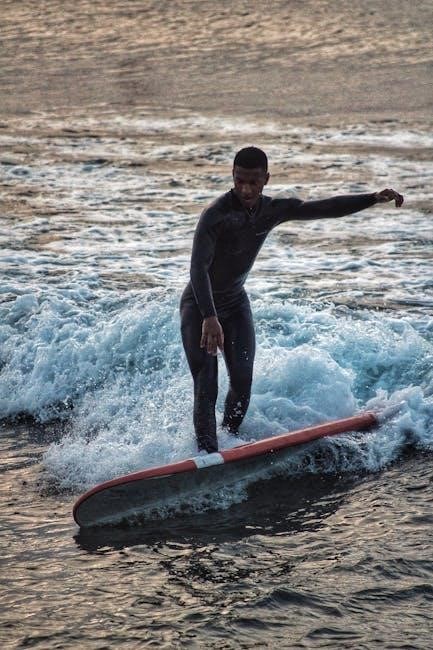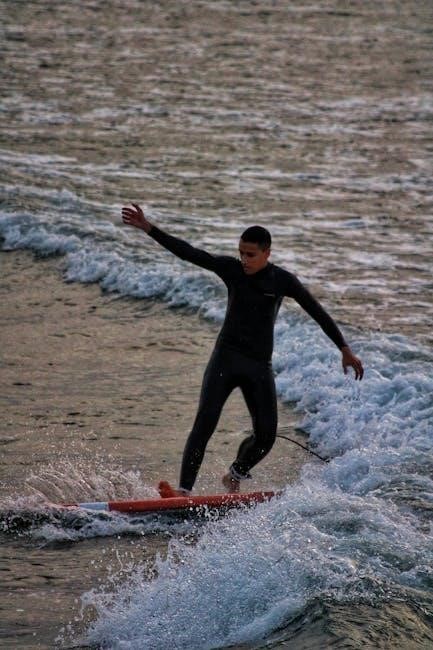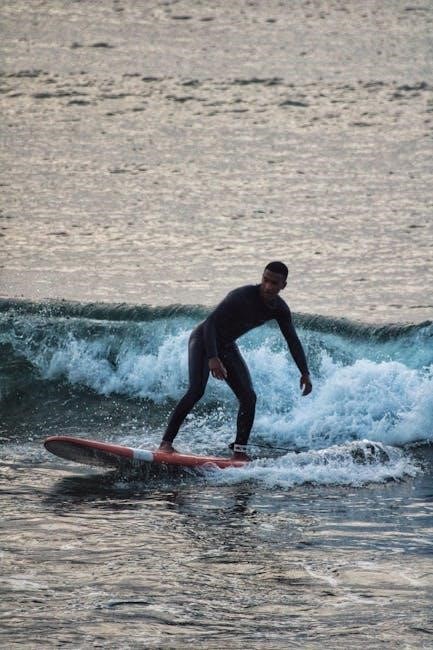A wetsuit is a essential garment for water sports, made from insulating neoprene that traps warm water next to your skin. Designed for surfing, diving, and swimming, it provides warmth, flexibility, and protection in various water conditions.

Types of Wetsuits
Wetsuits are tailored for specific water activities, including surfing, diving, swimming, and general water sports. Each type is designed to meet the unique demands of its intended use, ensuring optimal performance and comfort.
Surfing Wetsuits
Surfing wetsuits are specifically designed for the dynamic movements and high activity levels of surfing. They feature flexible neoprene panels that maximize range of motion, allowing surfers to paddle and maneuver effortlessly. Typically made from closed-cell neoprene, these suits are lightweight and durable, with reinforced knee panels to withstand abrasion from the board. Surfing wetsuits often have a slightly thicker core area (3-4mm) for warmth, while the arms and legs remain thinner (2-3mm) to maintain flexibility. Many include features like chest zippers for easy entry and thermal linings for added warmth. Designed to keep surfers comfortable in cooler waters, these wetsuits are a crucial piece of gear for extending session lengths and enhancing performance in the surf.

Diving Wetsuits
Diving wetsuits are engineered for underwater exploration, offering superior warmth and durability under pressure. Made from denser neoprene, they resist compression at depth, maintaining insulation. Key features include reinforced panels to protect against abrasion from dive gear like weight belts and BCDs. Diving wetsuits often have variable thickness, with thicker neoprene (3-4mm) around the core for warmth and thinner (2mm) neoprene on arms and legs for mobility. Glued and blind-stitched seams enhance durability, though they may leave temporary marks. Designed to withstand the rigors of diving, these suits are ideal for cold-water conditions. A snug fit is crucial to trap warm water next to the skin, ensuring thermal comfort. Accessories like hoods and gloves can further enhance warmth for extended dives. Whether for recreational or technical diving, a high-quality wetsuit is essential for safety and comfort underwater.
Swimming Wetsuits
Swimming wetsuits are tailored for aquatic athletes, prioritizing flexibility and hydrodynamics to enhance performance. Designed with thinner neoprene (1-2mm), they reduce drag while providing warmth in cooler waters. Key features include seamless construction underarms to minimize chafing and maximize mobility. Swimming wetsuits often have high-flex panels in the shoulders and arms for unrestricted strokes. They are ideal for triathletes, open-water swimmers, and those training in chilly conditions. Unlike diving wetsuits, swimming suits focus on lightweight, quick-drying materials to reduce water absorption and maintain buoyancy. Reinforced knee panels and smooth, durable exteriors protect against abrasion. Many swimming wetsuits also feature thermal linings for added warmth without compromising flexibility. Whether for racing or training, these suits are engineered to optimize efficiency and comfort in the water. A well-fitting swimming wetsuit can improve performance, reduce fatigue, and keep you warm during extended sessions.

General Water Sports Wetsuits
General water sports wetsuits are versatile and adaptable, catering to a broad range of aquatic activities. These suits are designed to provide a balance of warmth, flexibility, and durability for activities like kayaking, paddleboarding, or general water play. Typically made from medium-thickness neoprene (2-3mm), they offer excellent insulation without sacrificing mobility. Features such as reinforced knee panels and flatlock seams enhance durability, while smooth, flexible materials ensure comfort during active use. These wetsuits are ideal for casual users who engage in multiple water sports but do not require specialized suits for a single activity. Their universal design makes them a practical choice for anyone seeking a reliable, all-purpose wetsuit. Whether you’re exploring calm waters or engaging in light-intensity activities, general water sports wetsuits are a great option for staying warm and comfortable year-round.

Wetsuit Thickness Guide
Wetsuit thickness varies based on water temperature and activity needs. Thicker suits (5-7mm) are for cold water, while thinner (1-3mm) suits suit warm conditions. Choose based on your environment and sport requirements for optimal warmth and flexibility.
Warm Water vs. Cold Water Wetsuits
Choosing the right wetsuit thickness depends on water temperature. For warm waters (above 75°F/24°C), thinner wetsuits (1-3mm) are ideal, providing flexibility and minimal insulation. These suits are often made from open-cell neoprene, which offers more stretch but less warmth. In contrast, cold water requires thicker wetsuits (3-7mm) to retain body heat. Thicker neoprene, typically closed-cell, reduces heat loss and maintains insulation even under pressure. Variable thickness wetsuits combine thicker neoprene in the core (3-5mm) for warmth and thinner panels in the arms and legs (2mm) for mobility. For extremely cold conditions, semi-dry or dry suits may be necessary. Always consider your activity level and personal cold tolerance when selecting thickness. A well-chosen wetsuit ensures comfort and performance in any water temperature, whether surfing, diving, or swimming.
Variable Thickness Wetsuits
Variable thickness wetsuits combine different neoprene thicknesses in strategic areas to optimize warmth, flexibility, and mobility. Thicker panels (3-5mm) are typically used in the core (chest, abdomen, and back) for enhanced insulation, while thinner panels (2mm) are placed in the arms, shoulders, and legs for unrestricted movement. This design allows for better flexibility in areas requiring motion, such as paddling or swimming, while maintaining warmth in vital areas. For example, a common configuration is a 3/2mm wetsuit, with 3mm neoprene in the core and 2mm in the extremities. This balance makes variable thickness wetsuits ideal for activities like surfing or diving, where both warmth and mobility are essential. The variation in thickness ensures the suit adapts to the body’s needs, providing comfort and performance in diverse water conditions.
Choosing Thickness Based on Activity
Choosing the right wetsuit thickness depends on your primary water activity and the conditions you’ll encounter. For surfing, a 2-3mm wetsuit is ideal, offering flexibility and warmth without restricting movement. Divers, especially in colder waters, may opt for thicker suits (3-5mm) to withstand pressure and maintain insulation. Swimmers in warm waters often prefer thinner options (1-2mm) for reduced bulk and maximum mobility. For general water sports, a 2-3mm wetsuit strikes a balance between warmth and flexibility. Consider the water temperature, your activity’s demands, and your personal comfort level when selecting thickness. A thicker wetsuit provides more warmth but may limit flexibility, while a thinner one offers mobility but less insulation. Always prioritize fit and comfort to ensure optimal performance in your chosen activity.

Wetsuit Seams and Construction
Wetsuit seams significantly impact durability, flexibility, and performance. Flatlock seams are common, offering flexibility but less durability, while glued and blind stitched seams are more durable, leaving temporary marks on skin.
Flatlock Seams

Flatlock seams are a common construction method in wetsuits, created by overlapping neoprene panels and stitching them together without glue. This technique offers excellent flexibility, making it ideal for high-movement activities like surfing. The absence of glue ensures maximum stretch, allowing for a full range of motion in the water. However, flatlock seams are less durable compared to glued and blind stitched seams, as the stitching can be more prone to wear over time. Despite this, they remain popular for their comfort and mobility. Flatlock seams are often used in surfing wetsuits due to their ability to maintain flexibility, which is crucial for paddling and maneuvering on the board. While they may not provide the same level of longevity as other seam types, their performance in dynamic conditions makes them a practical choice for many water enthusiasts.
Glued and Blind Stitched Seams
Glued and blind stitched seams are a durable and watertight construction method used in wetsuits. This technique involves gluing the neoprene panels together before stitching, creating a strong bond that minimizes water entry. The stitching is then done from the inside, leaving a smooth exterior. This method is highly effective for cold-water wetsuits, as it reduces heat loss by preventing water from seeping through the seams. While glued and blind stitched seams are more durable than flatlock seams, they are less flexible, making them better suited for activities where warmth is a priority over extreme mobility. This construction is often found in diving wetsuits, where the added insulation and protection from abrasion are crucial. However, the reduced flexibility may make them less ideal for high-movement sports like surfing. Despite this, they remain a popular choice for their reliability and performance in colder conditions.



